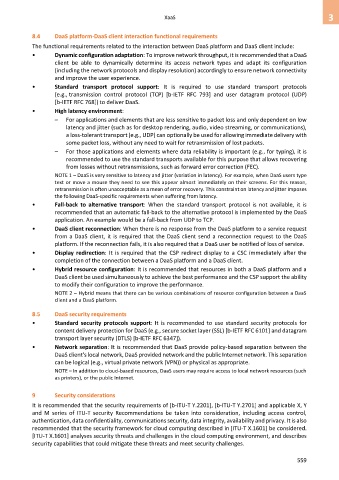Page 567 - Cloud computing: From paradigm to operation
P. 567
XaaS 3
8.4 DaaS platform-DaaS client interaction functional requirements
The functional requirements related to the interaction between DaaS platform and DaaS client include:
• Dynamic configuration adaptation: To improve network throughput, it is recommended that a DaaS
client be able to dynamically determine its access network types and adapt its configuration
(including the network protocols and display resolution) accordingly to ensure network connectivity
and improve the user experience.
• Standard transport protocol support: It is required to use standard transport protocols
(e.g., transmission control protocol (TCP) [b-IETF RFC 793] and user datagram protocol (UDP)
[b-IETF RFC 768]) to deliver DaaS.
• High latency environment:
– For applications and elements that are less sensitive to packet loss and only dependent on low
latency and jitter (such as for desktop rendering, audio, video streaming, or communications),
a loss-tolerant transport (e.g., UDP) can optionally be used for allowing immediate delivery with
some packet loss, without any need to wait for retransmission of lost packets.
– For those applications and elements where data reliability is important (e.g., for typing), it is
recommended to use the standard transports available for this purpose that allows recovering
from losses without retransmissions, such as forward error correction (FEC).
NOTE 1 – DaaS is very sensitive to latency and jitter (variation in latency). For example, when DaaS users type
text or move a mouse they need to see this appear almost immediately on their screens. For this reason,
retransmission is often unacceptable as a mean of error recovery. This constraint on latency and jitter imposes
the following DaaS-specific requirements when suffering from latency.
• Fall-back to alternative transport: When the standard transport protocol is not available, it is
recommended that an automatic fall-back to the alternative protocol is implemented by the DaaS
application. An example would be a fall-back from UDP to TCP.
• DaaS client reconnection: When there is no response from the DaaS platform to a service request
from a DaaS client, it is required that the DaaS client send a reconnection request to the DaaS
platform. If the reconnection fails, it is also required that a DaaS user be notified of loss of service.
• Display redirection: It is required that the CSP redirect display to a CSC immediately after the
completion of the connection between a DaaS platform and a DaaS client.
• Hybrid resource configuration: It is recommended that resources in both a DaaS platform and a
DaaS client be used simultaneously to achieve the best performance and the CSP support the ability
to modify their configuration to improve the performance.
NOTE 2 – Hybrid means that there can be various combinations of resource configuration between a DaaS
client and a DaaS platform.
8.5 DaaS security requirements
• Standard security protocols support: It is recommended to use standard security protocols for
content delivery protection for DaaS (e.g., secure socket layer (SSL) [b-IETF RFC 6101] and datagram
transport layer security (DTLS) [b-IETF RFC 6347]).
• Network separation: It is recommended that DaaS provide policy-based separation between the
DaaS client's local network, DaaS provided network and the public Internet network. This separation
can be logical (e.g., virtual private network (VPN)) or physical as appropriate.
NOTE – In addition to cloud-based resources, DaaS users may require access to local network resources (such
as printers), or the public Internet.
9 Security considerations
It is recommended that the security requirements of [b-ITU-T Y.2201], [b-ITU-T Y.2701] and applicable X, Y
and M series of ITU-T security Recommendations be taken into consideration, including access control,
authentication, data confidentiality, communications security, data integrity, availability and privacy. It is also
recommended that the security framework for cloud computing described in [ITU-T X.1601] be considered.
[ITU-T X.1601] analyses security threats and challenges in the cloud computing environment, and describes
security capabilities that could mitigate these threats and meet security challenges.
559

